\(\renewcommand\AA{\unicode{x212B}}\)
FFT v1¶
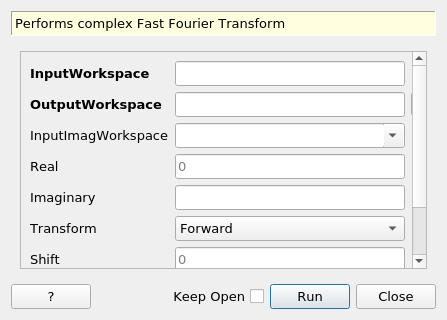
FFT dialog.¶
Summary¶
Performs complex Fast Fourier Transform
See Also¶
ExtractFFTSpectrum, FFTDerivative, MaxEnt, RealFFT, SassenaFFT, FFTSmooth
Properties¶
Name |
Direction |
Type |
Default |
Description |
|---|---|---|---|---|
InputWorkspace |
Input |
Mandatory |
The name of the input workspace. |
|
OutputWorkspace |
Output |
Mandatory |
The name of the output workspace. |
|
InputImagWorkspace |
Input |
The name of the input workspace for the imaginary part. Leave blank if same as InputWorkspace |
||
Real |
Input |
number |
0 |
Spectrum number to use as real part for transform |
Imaginary |
Input |
number |
Optional |
Spectrum number to use as imaginary part for transform |
Transform |
Input |
string |
Forward |
Direction of the transform: forward or backward. Allowed values: [‘Forward’, ‘Backward’] |
Shift |
Input |
number |
0 |
Apply an extra phase equal to this quantity times 2*pi to the transform |
AutoShift |
Input |
boolean |
False |
Automatically calculate and apply phase shift. Zero on the X axis is assumed to be in the centre - if it is not, setting this property will automatically correct for this. |
AcceptXRoundingErrors |
Input |
boolean |
False |
Continue to process the data even if X values are not evenly spaced |
Description¶
The FFT algorithm performs discrete Fourier transform of complex data using the Fast Fourier Transform algorithm. It uses the GSL Fourier transform functions to do the calculations. Due to the nature of the fast fourier transform the input spectra must have linear x axes. If the imaginary part is not set the data is considered real. The “Transform” property defines the direction of the transform: direct (“Forward”) or inverse (“Backward”).
Note that it is assumed that the input data has the x origin in the middle of the x-value range. It means that for the data defined on an interval [A,B] the output \(F(\xi_k)\) must be multiplied by \(e^{-2\pi ix_0\xi_k}\), where \(x_0=\tfrac{1}{2}(A+B)\) and \(\xi_k\) is the frequency. This can be achieved by using the input parameter Shift, which applies a phase shift to the transform, or by setting AutoShift on to do this automatically.
Details¶
The Fourier transform of a complex function \(f(x)\) is defined by equation:
For discrete data with equally spaced \(x_n\) and only non-zero on an interval \([A,B]\) the integral can be approximated by a sum:
Here \(\Delta x\) is the bin width, \(x_n=A+\Delta xn\). If we are looking for values of the transformed function \(F\) at discrete frequencies \(\xi_k=\Delta\xi k\) with
the equation can be rewritten:
Here \(f_n=f(x_n)\) and \(F_k=F(\xi_k)\). The formula
is the Discrete Fourier Transform (DFT) and can be efficiently evaluated using the Fast Fourier Transform algorithm. The DFT formula calculates the Fourier transform of data on the interval \([0,L]\). It should be noted that it is periodic in \(k\) with period \(N\). If we also assume that \(f_n\) is also periodic with period \(N\) the DFT can be used to transform data on the interval \([-L/2,L/2]\). To do this we swap the two halves of the data array \(f_n\). If we denote the modified array as \(\bar{f}_n\), its transform will be
The Mantid FFT algorithm returns the complex array \(\bar{F}_K\) as Y values of two spectra in the output workspace, one for the real and the other for the imaginary part of the transform. The X values are set to the transform frequencies and have the range approximately equal to \([-N/L,N/L]\). The actual limits depend slightly on whether \(N\) is even or odd and whether the input spectra are histograms or point data. The variations are of the order of \(\Delta\xi\). The zero frequency is always in the bin with index \(k=int(N/2)\).
The X values of the input data must be evenly spaced for the FFT algorithm to work (all bin widths must be the same). If they contain small rounding errors, this requirement can be relaxed by setting the AcceptXRoundingErrors property, which will continue to process the data even if the spacings between different X values are unequal. Large differences in the bin widths will still produce a warning.
If the X values are not centred on zero, the calculated phase will be wrong. The Shift property can be used to correct this - the value supplied is the value that should be added to the X values to centre the X axis. Setting the AutoShift property will automatically apply the correct shift (overriding any manually supplied Shift).
The algorithm works internally with point data - if a histogram workspace is provided as input, the bin edges are converted to points automatically inside the algorithm. The output transform is always a point data workspace. (It can be subsequently converted back to a histogram workspace using ConvertToHistogram v1, if required).
Example 1¶
In this example the input data were calculated using function \(\exp(-(x-1)^2)\) in the range [-5,5].
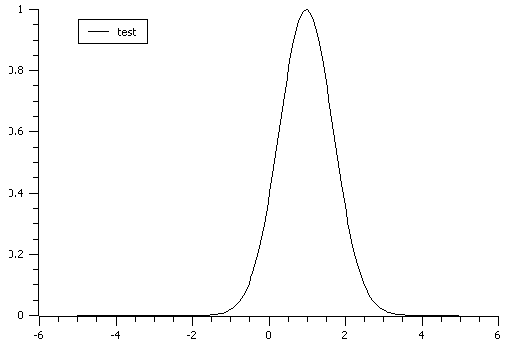
Gaussian¶
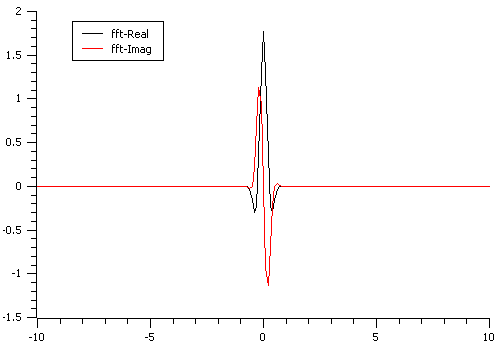
FFT of a Gaussian¶
Because the \(x=0\) is in the middle of the data array the transform shown is the exact DFT of the input data.
Example 2¶
In this example the input data were calculated using function \(\exp(-x^2)\) in the range [-6,4].
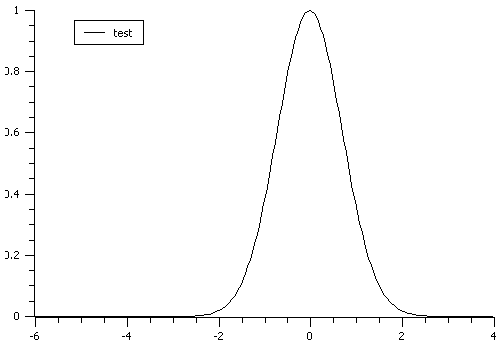
Gaussian¶

FFT of a Gaussian¶
Because the \(x=0\) is not in the middle of the data array the transform shown includes a shifting factor of \(\exp(2\pi i\xi)\). To remove it the output must be multiplied by \(\exp(-2\pi i\xi)\). The corrected transform will be:
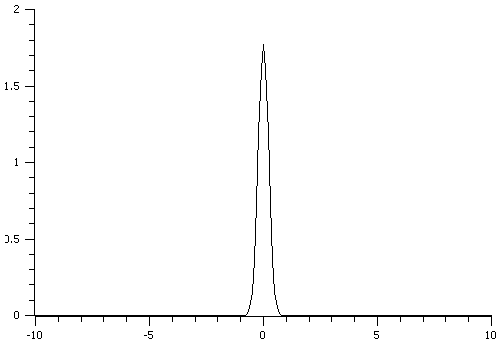
FFT of a Gaussian¶
It should be noted that in a case like this, i.e. when the input is a real positive even function, the correction can be done by finding the transform’s modulus \((Re^2+Im^2)^{1/2}\). The output workspace includes the modulus of the transform.
Output¶
The output workspace for a direct (“Forward”) transform contains either three or six spectra, depending on whether the input function is complex or purely real. If the input function has an imaginary part, the transform is written to three spectra with indexes 0, 1, and 2. Indexes 0 and 1 are the real and imaginary parts, while index 2 contains the modulus \(\sqrt{Re^2+Im^2}\). If the input function does not contain an spectrum for the imaginary part (purely real function), the actual transform is written to spectra with indexes 3 and 4 which are the real and imaginary parts, respectively. The last spectrum (index 5) has the modulus of the transform. The spectra from 0 to 2 repeat these results for positive frequencies only.
Output for the case of input function containing imaginary part:
Workspace index |
Description |
|---|---|
0 |
Complete real part |
1 |
Complete imaginary part |
2 |
Complete transform modulus |
Output for the case of input function containing no imaginary part:
Workspace index |
Description |
|---|---|
0 |
Real part, positive frequencies |
1 |
Imaginary part, positive frequencies |
2 |
Modulus, positive frequencies |
3 |
Complete real part |
4 |
Complete imaginary part |
5 |
Complete transform modulus |
The output workspace for an inverse (“Backward”) transform has 3 spectra for the real (0), imaginary (1) parts, and the modulus (2).
Workspace index |
Description |
|---|---|
0 |
Real part |
1 |
Imaginary part |
2 |
Modulus |
Usage¶
Example: Applying FFT algorithm
#Create Sample Workspace
ws = CreateSampleWorkspace(WorkspaceType = 'Event', NumBanks = 1, Function = 'Exp Decay', BankPixelWidth = 1, NumEvents = 100)
#apply the FFT algorithm - note output is point data
outworkspace = FFT(InputWorkspace = ws, Transform = 'Backward')
print("DataX(0)[1] equals DataX(0)[99]? : " + str((round(abs(outworkspace.dataX(0)[1]), 3)) == (round(outworkspace.dataX(0)[99], 3))))
print("DataX(0)[10] equals DataX(0)[90]? : " + str((round(abs(outworkspace.dataX(0)[10]), 3)) == (round(outworkspace.dataX(0)[90], 3))))
print("DataX((0)[50] equals 0? : " + str((round(abs(outworkspace.dataX(0)[50]), 3)) == 0))
print("DataY(0)[40] equals DataY(0)[60]? : " + str((round(abs(outworkspace.dataY(0)[40]), 5)) == (round(outworkspace.dataY(0)[60], 5))))
Output:
DataX(0)[1] equals DataX(0)[99]? : True
DataX(0)[10] equals DataX(0)[90]? : True
DataX((0)[50] equals 0? : True
DataY(0)[40] equals DataY(0)[60]? : True
Categories: AlgorithmIndex | Arithmetic\FFT
Source¶
C++ header: FFT.h
C++ source: FFT.cpp
